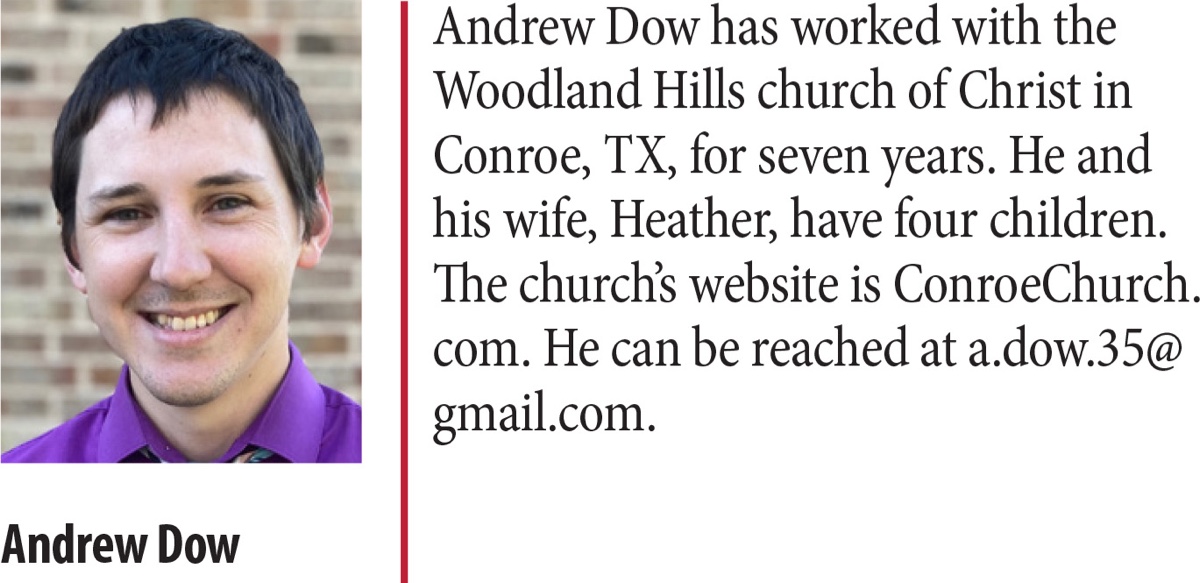By Andrew Dow
Synopsis: Before Paul gets into the nitty gritty of combatting false teaching, he encourages the Colossians to build a solid foundation by learning fully and properly who Jesus is.
In Colossians 2:6, Paul wrote, “Therefore as you have received Christ Jesus the Lord, so walk in Him.” This is a transition in the book of Colossians. Paul will spend time later explaining how to “walk.” Their “walk,” however, is a direct result of how they “received Christ Jesus the Lord.” This principle remains true for Christians today: what we believe about Jesus will shape how we live for Jesus.
In the letter to the Colossians, Paul issues warnings and corrections. Although the identity of the Colossian Heresy is beyond our scope, we know from the text that the Colossians need to prepare themselves for spiritual combat. While Paul confronts false ideas directly in chapter 2, he begins with a more fundamental approach. The most important thing for the Colossians to do is simply to understand who Jesus is. If they can remember how they “received Christ Jesus the Lord,” then they will be well equipped to “walk in Him.” Therefore, Paul begins this letter by reminding the Colossians exactly who Jesus is.
With relatively slight modifications, there is broad consensus on the structure of Colossians 1:1-2:5. The text can be divided as follows:
| Section | Verses |
|---|---|
| Greeting | (1:1-2) |
| Paul’s Thankfulness for the Colossians | (1:3-8) |
| Paul’s Prayer for the Colossians | (1:9-23) |
| Paul’s Work for the Colossians | (1:24-2:5) |
There is nothing particularly unusual about the things we find here. Paul’s greeting is typical. With one exception, Paul includes sections of thanksgiving in all his letters. Paul often expresses his prayers for his readers, and it is common for Paul to write about certain aspects of his apostolic work.
There is, however, one anomaly in the structure of chapter one. The oddity occurs in verses 15-20 where Paul abruptly breaks out in song! Although often lumped into Paul’s “prayer” section, this passage reflects a dramatic shift in style and content. The effect of this shift is to cause us to pay special attention. As we work our way through the text, we will emphasize this important section.
Paul begins by expressing his thankfulness for the Colossians. Namely, there are three qualities within them that are worthy of thanksgiving: “We have heard of your faith in Christ Jesus and the love which you have for all the saints; because of the hope laid up for you in heaven. . .” (1:3). Faith, hope, and love are often lumped together to summarize the most basic characteristics of the Christian life (e.g., 1 Thess. 1:3; 5:8; 1 Pet. 1:21-22). The Colossians, therefore, are doing something right and maturing well.
The Colossians are not merely commended for these qualities. They are also reminded where they first learned about them: “you previously heard [of these things] in the word of truth, the gospel” (1:5). Notice that Paul is subtly introducing the point he will make more clearly in 2:6. The Colossians’s actions (their faith, hope, and love) are an outgrowth of what they learned about Jesus through His Gospel.
Paul seamlessly moves from thankfulness to prayerfulness by linking the two together: “For this reason. . . we have not ceased to pray for you” (1:9a). Paul’s prayer for the Colossians is simple, but profound. He prays “that [the Colossians] may be filled with the knowledge of [God’s] will in all spiritual wisdom and understanding” (1:9b). The prayer is for knowledge. Elsewhere Paul commends and encourages knowledge of “the gospel” (1:5) and “God’s mystery” which is “Christ Himself” (2:3). The most important thing for the Colossians is that they know who Jesus is! If they know Jesus and His will, they will be ready to “walk in a manner worthy of the Lord” (1:10a), “please” God by “bearing fruit” and “increasing” (1:10b), and be “strengthened with all power” (1:11). To summarize Paul, an increasing and true knowledge of Jesus is necessary for those who want to live as His disciples.
In the midst of this prayer for increased knowledge, Paul inserts a poem (1:15-20). The prose of Paul’s typical letter writing is interrupted with rhythm and parallelism common to ancient poetry. Though the source of this poem is debated, it has been suggested by some that this might represent an ancient Christian hymn–perhaps a hymn the Colossians were familiar with or used in their own worship. Whatever the source of this poem might be, Paul uses it to teach important truths about Jesus. Truths that the Colossians already knew, yet should strive to know better.
First, the poem describes Jesus as being supreme over creation (1:15-17). Jesus is “the image of the invisible God” (1:15). By bearing God’s image perfectly, Jesus fulfills the mission of Genesis 1:26-27. Jesus is “the firstborn of all creation” (1:15). This is not a statement of chronology (i.e., that Jesus was created first), but one of status (cf. Ps. 88:20, 27; Exod. 4:22). Jesus holds the position of the firstborn with all of its authority. By Jesus, “all things were created. . .” (1:16). Based on these truths, the poem declares the relationship of Jesus to His creation: “He is before all things, and in Him all things hold together” (1:17). That is to say, Jesus is supreme over creation!
Second, the poem describes Jesus as being similarly supreme over a new kind of creation: His church (1:18-20). Just as the first half ended with a climactic declaration of Jesus’s relationship to creation, so this one begins: “He is also the head of the body, the church” (1:18a). What is it about Jesus that puts Him in this position of authority over God’s people? Jesus is “the beginning, the firstborn from the dead” (1:18b). This reference to resurrection highlights His authority not only over creation but also over those who will follow Him into a new kind of existence. Jesus has “the fullness” dwelling in Him (1:19). He does more than perfectly bear God’s image; He completely embodies God’s fullness (cf. 2:9). Finally, Jesus has reconciled all things to Himself (1:20). Just as He is the power behind our creation (1:16), it is only through Him that we can be reconciled to God and be recreated (1:13-14).
This poem serves as the basis for the remainder of the letter. When the Colossians face false teaching—whatever it may look like—they need to remember who Jesus is. When people come along and try to diminish Jesus or convince them that He is something less than what He claimed to be, they need to remember who Jesus is. After all, Jesus is the reason their lives changed in the first place (1:21-23).
Paul concludes his extended introductory remarks by letting the Colossians know about the work he has been doing. In this last stretch of verses, Paul aligns himself with the Colossians by clarifying that they are on the same team! Both the Colossians and Paul share in the knowledge of Jesus, which determines how they walk.
First, Paul describes broadly what his work entails. His time is spent doing two things: suffering (1:24) and teaching the gospel (1:28). Paul sees his life as being completely wrapped up in Jesus’s own work. By suffering, he carries on the work that Jesus’s own suffering began (1:25). By preaching, he continues to reveal the mystery that was first revealed in Jesus (1:27). So, broadly speaking, Paul’s work is indistinguishably tied to the purpose of Jesus in the gospel.
Second, Paul hones in on how his broader work impacts the Colossians. He hopes that his struggle produces results in their lives. Namely, that they might be “knit together in love. . . [attaining] the full assurance of understanding. . . [and producing] the stability of [their] faith in Christ” (2:1-5). Paul began by expressing thankfulness for their faith, love, and hope. Even so, his desire is that his work of preaching the gospel might produce increased love, assurance, and faith in the lives of the Colossians.
“Therefore as you have received Christ Jesus the Lord, so walk in Him. . .” (2:6). Before the Colossians learn how to walk, they need to know who Jesus is. My prayer and encouragement for us is that we might be filled with a desire to know Jesus. The solution to every issue we might encounter—whether it be in our lives, homes, or churches—is the gospel of Jesus Christ. The solution is knowing Jesus and walking in Him.



